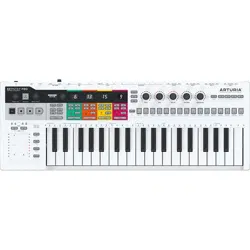Loading ...
Loading ...
Loading ...

5.3.3.2. Quick Edit Mode (Step Edit Button OFF)
When the Step Edit button is OFF, you can simply turn steps on or off by pressing their
step buttons. That might seem trivial, but it can make a big difference to the feel of your
sequence.
To edit the values stored in a step, hold the step and tweak one of the five knobs. The values
stored in the step will appear oin the display.
When you hold an empty step and touch or tweak one of it parameters, the value of these
parameters will appear in the display. It's a quick way of adding notes to your sequence.
When your sequence is running, the KeyStep Pro will light up the buttons of the steps that
are ON in your sequence. You can do several things now:
• Hold down the Trans (Transpose) button and press a key on the keyboard to
transpose your sequence up or down.
• Press 'Shift' + Invert (step button 5) to create a mirror image of your sequence,
and press 'Shift' + Invert once more to restore the natural order of things (;-)
• Nudge the looping sequence as a whole to the left or right (backward or forward
in time). To nudge to the left, hold down 'Shift' and press < Nudge (step button
3); to nudge to the right, hold down 'Shift' and press Nudge > (step button 4). The
note or notes in the first step of the loop will move to the second step; the note or
notes in the last step will wrap around to the first step.
There is another interesting option in Quick edit mode we haven't explored yet: by holding
down a step button, you can edit all parameters – Pitch, Gate, Velocity, Time Shift and
Randomness – of the note or notes stored in that step by turning the appropriate encoders.
You can even do this
selectively
by activating Advanced Edit mode [p.85] with Overdub. For
example, to lengthen the gate time of only two notes of a four-note chord, select them by
pressing the appropriate keys and turn the Gate encoder to the right. How cool is that?
Pressing the Tie/Rest button increases the gate length of the selected notes but doesn’t move
the cursor, nor does it erase the content of the next step.
Quick edit mode is ideal for creating accented velocity values. Remember that in quick edit
mode, any new notes you enter in the sequence will have the current pitch, gate, velocity
time-shift and randomness value. You can use this to your advantage to create accented
steps in a pattern. Here's how to do that:
• Make certain Record mode and Step Edit mode are not active.
Let's create a sequence in which the velocity values alternate between soft and loud. The
even steps are loud, the odd steps soft;
• Select an empty sequence
• Set velocity to 120
• Hold a key and press step 1
• Hold another key and press step 3
• Continue to fill the odd steps with notes of a velocity value of 120
Now set velocity to 60 and fill the even steps with other pitches. Each step you add will have
a velocity value of 60. When you now playback the sequence, the volume will alternate
between loud and soft each time the sequencer advances.
When all keys are released, the Quick Editing process is complete.
84 Arturia - User Manual Keystep Pro - Making Tracks
Loading ...
Loading ...
Loading ...
